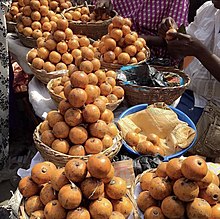Gambeya albida: Difference between revisions
Edderiofer (talk | contribs) Added inconsistent template for the name of the species. |
No edit summary Tags: Mobile edit Mobile web edit |
||
| Line 11: | Line 11: | ||
'''''Chrysophyllum africanum'''''{{Inconsistent|date=January 2022}} (commonly known as '''African''' '''star apple'''<ref name=GRIN>{{GRIN | accessdate=12 March 2013}}</ref>) is a forest fruit tree commonly found throughout tropical [[Africa]].<ref name=GRIN/> |
'''''Chrysophyllum africanum'''''{{Inconsistent|date=January 2022}} (commonly known as '''African''' '''star apple'''<ref name=GRIN>{{GRIN | accessdate=12 March 2013}}</ref>) is a forest fruit tree commonly found throughout tropical [[Africa]].<ref name=GRIN/> |
||
[[File:African Star Apple Fruit in Ghana.jpg|thumb|African star apple]] |
[[File:African Star Apple Fruit in Ghana.jpg|thumb|African star apple]] |
||
Amongst the [[Yoruba people|Yoruba]] of [[Nigeria]], it is called Agbalumo while it is called udala (udara) in [[Igbo people | the Igbo]], with the usage of the latter term, coincidentally, also permeating across much of southern Nigeria (i.e.,further east of Akoko-Ondo) the northern (Hausa-Fulani) parts of the country. One local enduring sobriquet is derived from the [[Yoruba people | Yoruba]] agbalumo, i.e., ‘agbaluma,’ and is used in certain parts of Nigeria. |
|||
| ⚫ | |||
The inherent sweetness of a child (or person of especially-seasoned cognisance/age who otherwise displays certain amiability-desirable characteristics representative of children and/or well-adjusted adults, e.g., well-roundedness, joviality, unassuming understanding) has been likened to the fruit in [[Igbo people | Igbo]], as ‘udala nwannu.’ |
|||
| ⚫ | .<ref name=LostCrops>{{cite book|title=Lost Crops of Africa: Volume III: Fruits|year=2008|publisher=The National Academies Press|location=Washington, DC|isbn=978-0-309-10596-5|pages=321|url=http://books.nap.edu/openbook.php?record_id=11879&page=320}}</ref> It is closely related to the African star apple''([[Chrysophyllum africanum]]'') which is also common throughout West Africa. Some schools of thought feel that they may just be a variety of the same species. Also in the family is the purple star apple (''[[Chrysophyllum cainito]]'').<ref name=LostCrops/> |
||
==References== |
==References== |
||
Revision as of 21:31, 6 June 2022
| Gambeya albida | |
|---|---|
| Scientific classification | |
| Kingdom: | Plantae |
| Clade: | Tracheophytes |
| Clade: | Angiosperms |
| Clade: | Eudicots |
| Clade: | Asterids |
| Order: | Ericales |
| Family: | Sapotaceae |
| Genus: | Chrysophyllum |
| Species: | C. africanum
|
| Binomial name | |
| Chrysophyllum africanum | |
Chrysophyllum africanum[inconsistent] (commonly known as African star apple[1]) is a forest fruit tree commonly found throughout tropical Africa.[1]

Amongst the Yoruba of Nigeria, it is called Agbalumo while it is called udala (udara) in the Igbo, with the usage of the latter term, coincidentally, also permeating across much of southern Nigeria (i.e.,further east of Akoko-Ondo) the northern (Hausa-Fulani) parts of the country. One local enduring sobriquet is derived from the Yoruba agbalumo, i.e., ‘agbaluma,’ and is used in certain parts of Nigeria.
The inherent sweetness of a child (or person of especially-seasoned cognisance/age who otherwise displays certain amiability-desirable characteristics representative of children and/or well-adjusted adults, e.g., well-roundedness, joviality, unassuming understanding) has been likened to the fruit in Igbo, as ‘udala nwannu.’
.[2] It is closely related to the African star apple(Chrysophyllum africanum) which is also common throughout West Africa. Some schools of thought feel that they may just be a variety of the same species. Also in the family is the purple star apple (Chrysophyllum cainito).[2]
References
- ^ a b "Gambeya albida". Germplasm Resources Information Network. Agricultural Research Service, United States Department of Agriculture.
{{citation}}:|access-date=requires|url=(help) - ^ a b Lost Crops of Africa: Volume III: Fruits. Washington, DC: The National Academies Press. 2008. p. 321. ISBN 978-0-309-10596-5.
- National Research Council. 2008. Lost Crops of Africa: Volume III: Fruits. Washington, DC: The National Academies Press. https://doi.org/10.17226/11879
External links
National Research Council. 2008. Lost Crops of Africa: Volume III: Fruits. Washington, DC: The National Academies Press. https://doi.org/10.17226/11879
